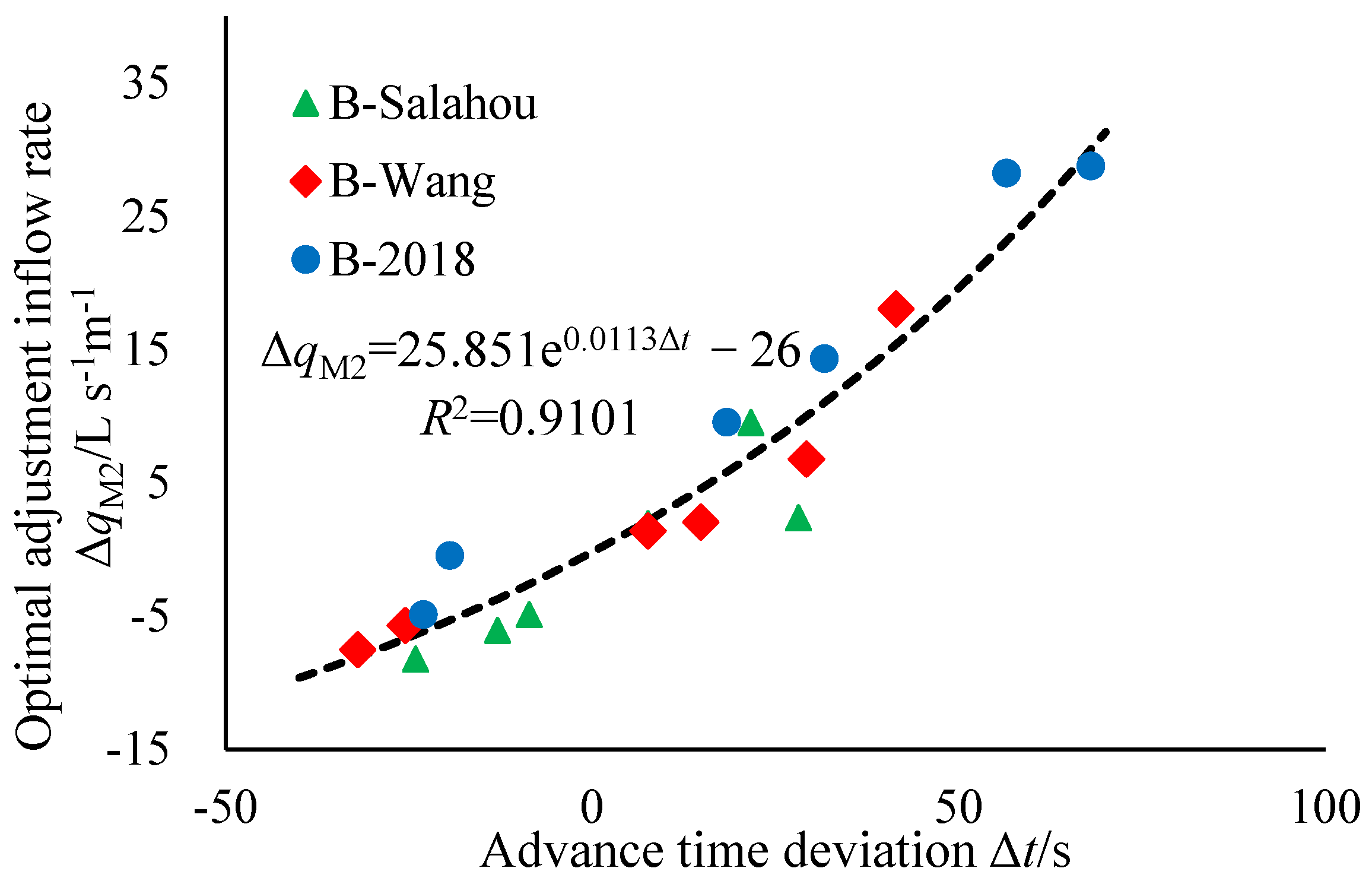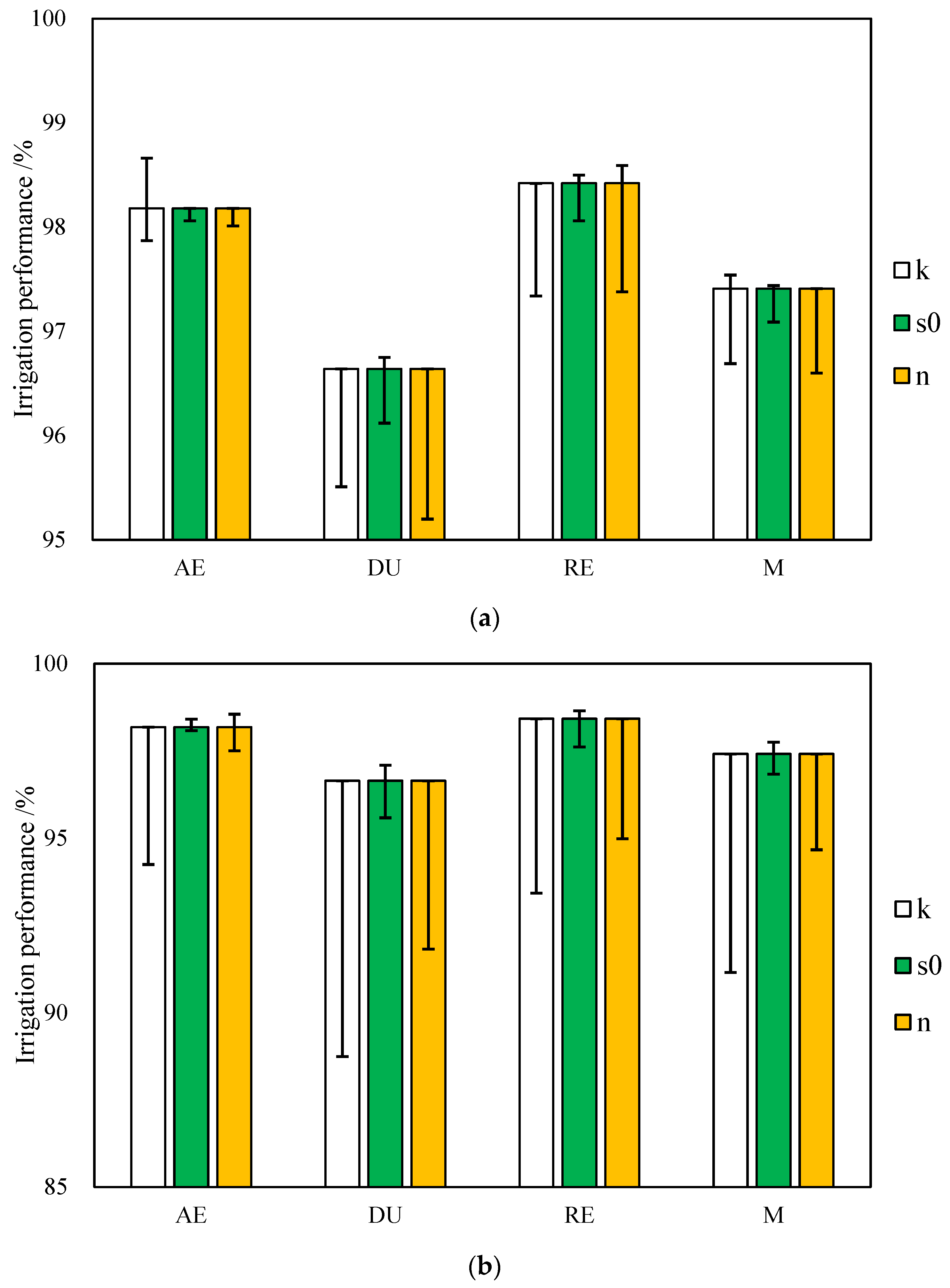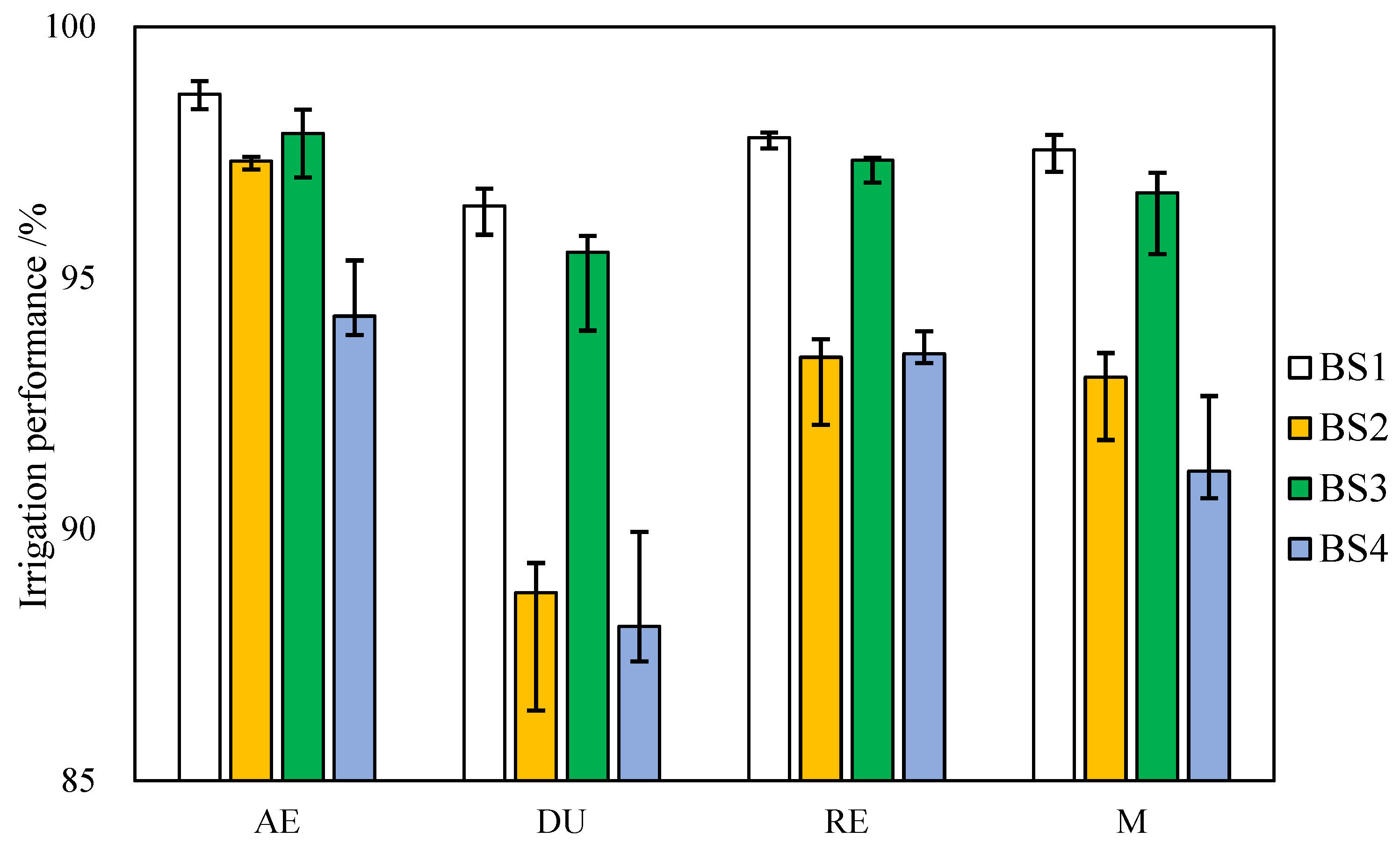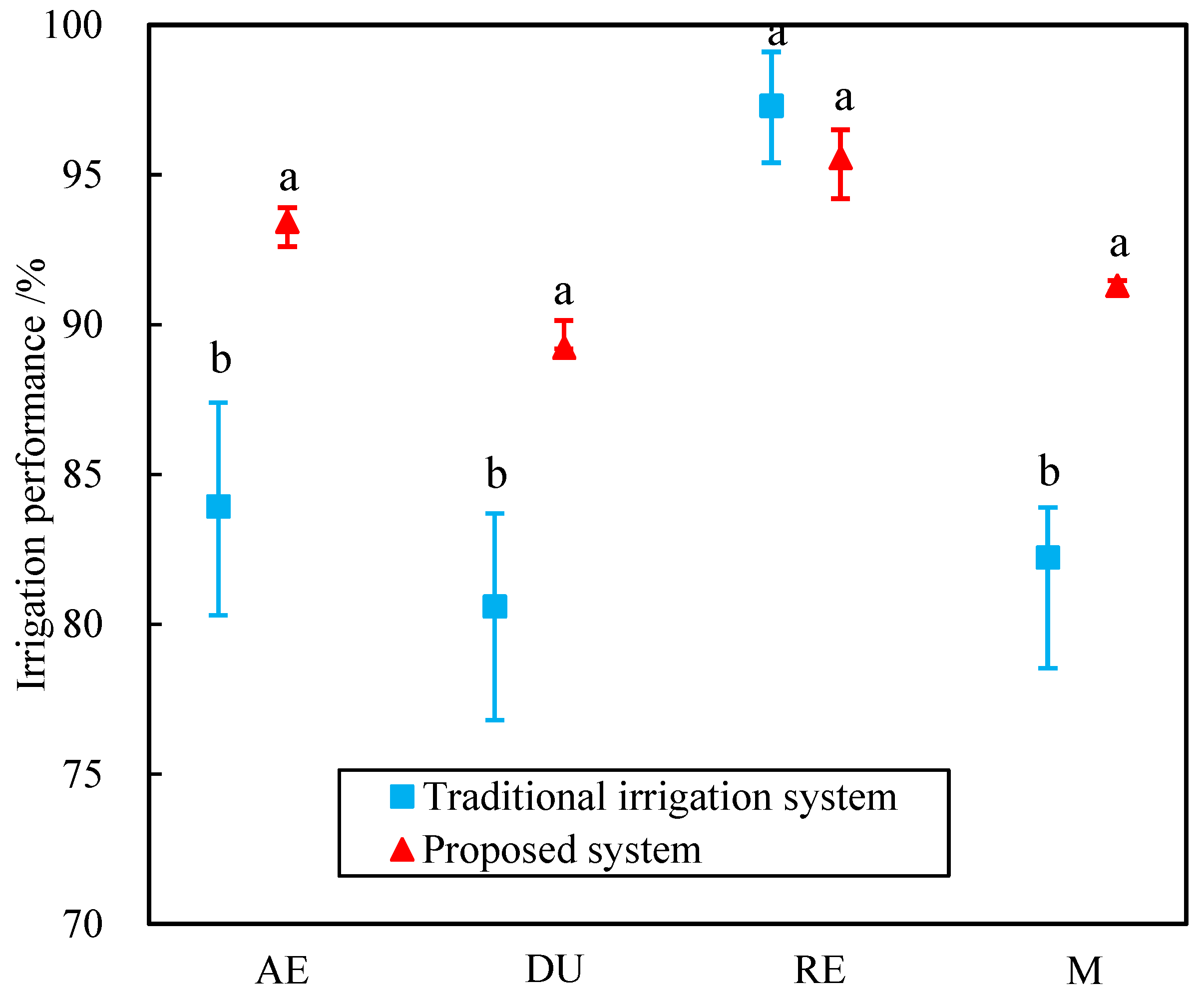Improving Irrigation Performance by Using Adaptive Border Irrigation System
Abstract
:1. Introduction
2. Materials and Methods
2.1. Overall Design of the System
2.2. Inflow Adjustment Simulation and Border Parameters
2.3. Sensitivity Analysis and Field Experiment
2.4. Statistic Analysis
3. Results and Discussion
3.1. Inflow Adjustment Strategy
3.1.1. First Inflow Adjustment
3.1.2. Second Inflow Adjustment
3.2. Sensitivity Analysis
3.2.1. Sensitivity to Natural Parameters
3.2.2. Sensitivity to Inflow Rate
3.2.3. Sensitivity to Border Length
3.3. Experimental Verification and System Evaluation
4. Conclusions
Author Contributions
Funding
Data Availability Statement
Conflicts of Interest
References
- Caner, Y.; Ustun, S.; Selda, O.; Fatih, M.K. Improvement of water and crop productivity of silage maize by irrigation with different levels of recycled wastewater under conventional and zero tillage conditions. Agric. Water Manag. 2023, 277, 108100. [Google Scholar]
- Zhang, F.; Chen, X.; Vitousek, P.M. Chinese agriculture: An experiment for the world. Nature 2013, 497, 33–35. [Google Scholar] [CrossRef] [PubMed]
- Nie, W.B.; Li, Y.B.; Zhang, F.; Ma, X.Y. Optimal discharge for closed-end border irrigation under soil infiltration variability. Agric. Water Manag. 2019, 221, 58–65. [Google Scholar] [CrossRef]
- Xu, J.; Cai, H.; Saddique, Q.; Wang, X.; Li, L.; Ma, C.; Lu, Y. Evaluation and optimization of border irrigation in different irrigation seasons based on temporal variation of infiltration and roughness. Agric. Water Manag. 2019, 214, 64–77. [Google Scholar] [CrossRef]
- Nie, W.B.; Dong, S.X.; Li, Y.B.; Ma, X.Y. Optimization of the border size on the irrigation district scale—Example of the Hetao irrigation district. Agric. Water Manag. 2021, 248, 106768. [Google Scholar] [CrossRef]
- Bai, M.; Li, Y.; Tu, S.; Liu, Q. Analysis on cutoff time optimization of border irrigation to improve irrigated water quality. Trans. Chin. Soc. Agric. Eng. 2016, 32, 105–110. [Google Scholar]
- Chen, B.; Ouyang, Z.; Sun, Z.; Wu, L.; Li, F. Evaluation on the potential of improving border irrigation performance through border dimensions optimization: A case study on the irrigation districts along the lower Yellow River. Irrig. Sci. 2013, 31, 715–728. [Google Scholar] [CrossRef]
- Smith, R.J.; Uddin, M.J. Selection of flow rate and irrigation duration for high performance bay irrigation. Agric. Water Manag. 2020, 228, 11. [Google Scholar] [CrossRef]
- Wu, C.; Bai, M.; Li, Y. Review on intelligent management of surface irrigation under intensive condition. J. Water Resour. Archit. Eng. 2019, 017, 222–227. (In Chinese) [Google Scholar]
- Morris, M.R.; Hussain, A.; Gillies, M.H.; O’Halloran, N.J. Inflow rate and border irrigation performance. Agric. Water Manag. 2015, 155, 76–86. [Google Scholar] [CrossRef]
- Mazarei, R.; Soltani Mohammadi, A.; Ebrahimian, H.; Naseri, A.A. Temporal variability of infiltration and roughness coefficients and furrow irrigation performance under different inflow rates. Agric. Water Manag. 2021, 245, 106465. [Google Scholar] [CrossRef]
- Gonzalez, C.R.; Cervera, L.; Moretfernandez, D. Basin irrigation design with longitudinal slope. Agric. Water Manag. 2011, 98, 1516–1522. [Google Scholar] [CrossRef]
- Smith, R.J.; Uddin, J.M.; Gillies, M.H.; Moller, P.; Clurey, K. Evaluating the performance of automated bay irrigation. Irrig. Sci. 2016, 34, 175–185. [Google Scholar] [CrossRef]
- Abioye, E.A.; Abidin, M.S.Z.; Mahmud, M.S.A.; Buyamin, S.; Ishak, M.H.I.; Abd Rahman, M.K.I.; Otuoze, A.O.; Onotu, P.; Ramli, M.S.A. A review on monitoring and advanced control strategies for precision irrigation. Comput. Electron. Agric. 2020, 173, 22. [Google Scholar] [CrossRef]
- Zhao, H.; Di, L.; Yu, E.; Guo, L.; Li, L.; Zhang, C.; Li, L. A Review of Scientific Irrigation Scheduling Methods. In Proceedings of the 2023, 11th International Conference on Agro-Geoinformatics (Agro-Geoinformatics), Wuhan, China, 25–28 July 2023; pp. 1–4. [Google Scholar] [CrossRef]
- Zhao, H.; Di, L.; Guo, L.; Zhang, C.; Lin, L. An Automated Data-Driven Irrigation Scheduling Approach Using Model Simulated Soil Moisture and Evapotranspiration. Sustainability 2023, 15, 12908. [Google Scholar] [CrossRef]
- Zhao, H.; Di, L.; Guo, L.; Zhang, C.; Yu, E.; Li, H. Optimizing Irrigation Scheduling Using Deep Reinforcement Learning. In Proceedings of the 2023, 11th International Conference on Agro-Geoinformatics (Agro-Geoinformatics), Wuhan, China, 25–28 July 2023; pp. 1–4. [Google Scholar] [CrossRef]
- Reddell, D.; Latimer, E. Advance Rate Feedback Irrigation System (ARFIS); Microfiche Collection (USA); American Society of Agricultural Engineers: St. Joseph, MI, USA, 1986. [Google Scholar]
- Latimer, E.; Reddell, D. Components for an advance rate feedback irrigation system (ARHS). Trans. ASAE 1990, 33, 1162–1170. [Google Scholar] [CrossRef]
- Clemmens, A.; Keats, J. Bayesian inference for feedback control. II: Surface irrigation example. J. Irrig. Drain. Eng. 1992, 118, 416–432. [Google Scholar] [CrossRef]
- Khatri, K.L.; Smith, R. Toward a simple real-time control system for efficient management of furrow irrigation. Irrig. Drain. J. Int. Comm. Irrig. Drain. 2007, 56, 463–475. [Google Scholar] [CrossRef]
- Koech, R.; Smith, R.; Gillies, M. A real-time optimisation system for automation of furrow irrigation. Irrig. Sci. 2014, 32, 319–327. [Google Scholar] [CrossRef]
- Li, J.; Huang, Z.; Li, T.; Jiao, X.; Shi, C. Regulation of border irrigation technical elements considering condition of uneven initial soil moisture content along border. Trans. Chin. Soc. Agric. Mach. 2023, 54, 320–329+370. (In Chinese) [Google Scholar]
- Liu, K.; Jiao, X.; Jiang, L.; Gu, Z.; Guo, W. A Real-Time Adaptive Control System for Border Irrigation. Agronomy 2022, 12, 2995. [Google Scholar] [CrossRef]
- Salahou, M.K.; Jiao, X.; Lü, H. Border irrigation performance with distance-based cut-off. Agric. Water Manag. 2018, 201, 27–37. [Google Scholar] [CrossRef]
- Wu, C.; Xu, D.; Bai, M.; Li, Y.; Li, F. Real-time feedback control technology for precise furrow irrigation. J. Drain. Irrig. Mach. Eng. 2020, 38, 536–540. (In Chinses) [Google Scholar]
- Jiao, X.; Wang, W. Robust Design of Border Irrigation and Furrow Irrigation; Hohai University Press: Nanjing, China, 2012. (In Chinese) [Google Scholar]
- Bautista, E.; Clemmens, A.J.; Strelkoff, T.S.; Schlegel, J. Modern analysis of surface irrigation systems with WinSRFR. Agric. Water Manag. 2009, 96, 1146–1154. [Google Scholar] [CrossRef]
- Liu, K.; Jiao, X.; Li, J.; An, Y.; Guo, W.; Salahou, M.K.; Sang, H. Performance of a zero-inertia model for irrigation with rapidly varied inflow discharges. Int. J. Agric. Biol. Eng. 2020, 13, 175–181. [Google Scholar] [CrossRef]
- Schwankl, L.; Raghuwanshi, N.; Wallender, W. Furrow irrigation performance under spatially varying conditions. J. Irrig. Drain. Eng. 2000, 126, 355–361. [Google Scholar] [CrossRef]
- Trout, T.J.; Mackey, B.E. Furrow inflow and infiltration variability. Trans. ASAE 1988, 31, 531–0537. [Google Scholar] [CrossRef]
- Nie, W.-B.; Li, Y.-B.; Zhang, F.; Dong, S.-X.; Wang, H.; Ma, X.-Y. A Method for Determining the Discharge of Closed-End Furrow Irrigation Based on the Representative Value of Manning’s Roughness and Field Mean Infiltration Parameters Estimated Using the PTF at Regional Scale. Water 2018, 10, 1825. [Google Scholar] [CrossRef]
- Koech, R.K.; Smith, R.J.; Gillies, M.H. Evaluating the performance of a real-time optimisation system for furrow irrigation. Agric. Water Manag. 2014, 142, 77–87. [Google Scholar] [CrossRef]
- Lei, G.; Fan, G. Practical Optimization Model for Technical Parameters of Border Irrigation. Yellow River 2017, 39, 149–152. (In Chinese) [Google Scholar]
- Bautista, E.; Wallender, W. Spatial variability of infiltration in furrows. Trans. ASAE 1985, 28, 1846–1851. [Google Scholar] [CrossRef]
- Nie, W.; Fei, L.; Ma, X. Effects of Spatial Variability of Soil Infiltration Characteristics and Manning Roughness on Furrow Irrigation Performance. Trans. Chin. Soc. Agric. Mach. 2014, 45, 108–114. (In Chinese) [Google Scholar]
- Liu, K.H.; Jiao, X.Y.; Guo, W.H.; An, Y.H.; Salahou, M.K. Improving border irrigation performance with predesigned varied-discharge. PLoS ONE 2020, 15, e232751. [Google Scholar] [CrossRef] [PubMed]
- Khatri, K.L.; Memon, A.A.; Shaikh, Y.; Pathan, A.; Shah, S.A.; Pinjani, K.K.; Soomro, R.; Smith, R.; Almani, Z. Real-Time Modelling and Optimisation for Water and Energy Efficient Surface Irrigation. J. Water Resour. Prot. 2013, 5, 681–688. [Google Scholar] [CrossRef]







| Comparison | Proposed System | RACI | Traditional Real-Time Control Irrigation | ||
|---|---|---|---|---|---|
| Surface flow sensors | Layout | The first monitoring point is located at 40 m, and the spacing between subsequent monitoring points is 30 m | The first monitoring point is located at 40 m, and the spacing between subsequent monitoring points is 10 m | The monitoring points are concentrated in the front section of the border field (usually no less than 60 m), and the layout interval is usually 5 m or 10 m | |
| Amount for a classic border | 100-m-long border | 2 | 5 | 5 or 12 | |
| 150-m-long border | 4 | 10 | 5 or 12 | ||
| 200-m-long border | 5 | 13 | 5 or 12 | ||
| Adjustment basis | Difference between actual and expected advance time and inflow adjustment strategy | Difference between actual and expected advance time | Real-time calculation of natural parameters and simulation of irrigation process | ||
| Calculation | Function | Exponential function | Logic function | Partial differential equations | |
| Equipment requirements | Simple computing equipment (such as single-chip microcomputer) | Simple computing equipment (such as single-chip microcomputer) | Equipment capable of performing complex calculations in a short time (such as computer) | ||
| Border | Border Specification | Infiltration Parameters | Slope s0 | Roughness n | Irrigation Water Requirement m (mm) | ||
|---|---|---|---|---|---|---|---|
| Length L (m) | Width D (m) | k (mm min−α) | α | ||||
| B-Salahou | 100 | 3.7 | 7.55 | 0.68 | 0.0025 | 0.06 | 60 |
| B-2018 | 100 | 3.0 | 13.94 | 0.47 | 0.0017 | 0.16 | 90 |
| B-Wang | 110 | 2.0 | 9.30 | 0.58 | 0.0034 | 0.08 | 60 |
| Number | Simulated Scenarios | Natural Parameters | |||
|---|---|---|---|---|---|
| Infiltration Parameters | Slope s0 | Roughness n | |||
| K (mm min−α) | α | ||||
| BS0 | Original value | 13.94 | 0.47 | 0.0017 | 0.16 |
| BS1 | Infiltration coefficient +10% | 15.33 | 0.47 | 0.0017 | 0.16 |
| BS2 | Infiltration coefficient +20% | 16.44 | 0.47 | 0.0017 | 0.16 |
| BS3 | Infiltration coefficient −10% | 12.55 | 0.47 | 0.0017 | 0.16 |
| BS4 | Infiltration coefficient −20% | 11.15 | 0.47 | 0.0017 | 0.16 |
| BS5 | Slope +10% | 13.94 | 0.47 | 0.0019 | 0.16 |
| BS6 | Slope +20% | 13.94 | 0.47 | 0.0020 | 0.16 |
| BS7 | Slope −10% | 13.94 | 0.47 | 0.0015 | 0.16 |
| BS8 | Slope −20% | 13.94 | 0.47 | 0.0014 | 0.16 |
| BS9 | Roughness +10% | 13.94 | 0.47 | 0.0017 | 0.17 |
| BS10 | Roughness +20% | 13.94 | 0.47 | 0.0017 | 0.19 |
| BS11 | Roughness −10% | 13.94 | 0.47 | 0.0017 | 0.15 |
| BS12 | Roughness −20% | 13.94 | 0.47 | 0.0017 | 0.13 |
| Border | Optimal Constant-Discharge Irrigation Scheme | Expected Advance Time of Observation Points (min) | Irrigation Performance (%) | ||||
|---|---|---|---|---|---|---|---|
| Inflow Rate q0 (L s−1 m−1) | Cut-Off Time tT (min) | 40 m | 70 m | AE | DU | RE | |
| B-Salahou | 6.2 | 16.13 | 6.24 | 13.00 | 97.87 | 92.60 | 95.23 |
| B-2018 | 4.8 | 31.26 | 14.03 | 29.01 | 98.19 | 96.64 | 97.41 |
| B-Wang | 5.8 | 18.97 | 7.75 | 15.22 | 96.12 | 93.34 | 94.73 |
| Border | Infiltration Parameters k (mm min−α) | Initial Flow Rate q0 (L s−1 m−1) | Advance Time Deviation Δt (s) | Optimal Adjustment Inflow Rate ΔqM1 (L s−1 m−1) | Inflow Rate after Adjustment qM1 (L s−1 m−1) | Irrigation Performance M (%) |
|---|---|---|---|---|---|---|
| B-Salahou | 8.17 | 6.2 | 7.9 | 1.1 | 7.3 | 93.83 |
| 8.79 | 6.2 | 17.6 | 3.3 | 9.5 | 93.29 | |
| 7.55 | 6.2 | 0 | 0 | 6.2 | 94.36 | |
| 6.93 | 6.2 | −9.4 | −1.4 | 4.8 | 95.32 | |
| 6.32 | 6.2 | −46.4 | −2.3 | 3.9 | 95.46 | |
| 9.41 | 6.2 | 27.7 | 5.7 | 11.9 | 93.06 | |
| B-2018 | 15.97 | 4.8 | 33.1 | 7.2 | 12.0 | 97.86 |
| 13.69 | 4.8 | −18.7 | −1.4 | 3.4 | 97.32 | |
| 14.14 | 4.8 | −8.6 | −0.9 | 3.9 | 97.23 | |
| 15.21 | 4.8 | 15.5 | 1.9 | 6.7 | 97.42 | |
| 16.42 | 4.8 | 43.9 | 12.7 | 17.5 | 97.66 | |
| 12.93 | 4.8 | −35.3 | −2.2 | 2.6 | 97.47 | |
| B-Wang | 10.23 | 5.8 | 14.8 | 1.7 | 7.5 | 93.95 |
| 10.89 | 5.8 | 25.6 | 3.7 | 9.5 | 94.20 | |
| 8.56 | 5.8 | −11.2 | −1.5 | 4.3 | 94.31 | |
| 7.91 | 5.8 | −20.2 | −2.3 | 3.5 | 94.83 | |
| 11.35 | 5.8 | 33.5 | 6.9 | 12.7 | 94.38 | |
| 7.44 | 5.8 | −26.6 | −2.6 | 3.2 | 94.72 |
| Border | Initial Flow Rate q0 (L s−1 m−1) | First Adjustment (40 m) | Second Adjustment (70 m) | Irrigation Performance M (%) | ||||
|---|---|---|---|---|---|---|---|---|
| Advance Time Deviation Δt1 (s) | Optimal Adjustment Inflow Rate ΔqM1 (L s−1 m−1) | Inflow Rate after Adjustment qM1 (L s−1 m−1) | Advance Time Deviation Δt2 (s) | Optimal Adjustment Inflow Rate ΔqM2 (L s−1 m−1) | Inflow Rate after Adjustment qM2 (L s−1 m−1) | |||
| B-Salahou | 6.2 | −6.5 | 1.9 | 8.1 | −13.0 | −6.1 | 2.0 | 92.45 |
| 6.2 | 6.5 | −1.1 | 5.1 | 7.6 | 1.9 | 7.0 | 94.60 | |
| 6.2 | −11.8 | 2.2 | 8.4 | −8.6 | −4.9 | 3.5 | 94.24 | |
| 6.2 | 4.68 | −0.8 | 5.4 | 28.1 | 2.4 | 7.8 | 93.35 | |
| 6.2 | −3.96 | −0.7 | 5.5 | 21.6 | 9.6 | 15.1 | 94.05 | |
| 6.2 | −7.56 | 3 | 9.2 | −24.1 | −8.2 | 1.0 | 91.56 | |
| B-2018 | 4.8 | 15.5 | −0.8 | 4.0 | 18.4 | 9.5 | 13.5 | 97.07 |
| 4.8 | −9.4 | 0.6 | 5.4 | −23.0 | −4.9 | 0.5 | 96.13 | |
| 4.8 | 17.3 | −1.3 | 3.5 | 68.0 | 28.8 | 32.3 | 97.38 | |
| 4.8 | −5.0 | 0.4 | 5.2 | −19.4 | −0.5 | 4.7 | 95.87 | |
| 4.8 | −4.3 | −0.6 | 4.2 | 31.9 | 14.3 | 18.5 | 96.17 | |
| 4.8 | 21.2 | −0.9 | 3.9 | 56.5 | 28.2 | 32.1 | 97.03 | |
| B-Wang | 5.8 | 19.4 | 2.7 | 8.5 | −32.0 | −7.5 | 1.0 | 92.44 |
| 5.8 | 16.6 | 2.1 | 7.9 | −25.6 | −5.7 | 2.2 | 94.48 | |
| 5.8 | −18.4 | −1.7 | 4.1 | 7.6 | 1.4 | 5.5 | 94.32 | |
| 5.8 | −13.7 | −1.4 | 4.4 | 14.8 | 2 | 6.4 | 94.72 | |
| 5.8 | −31.7 | −2.3 | 3.5 | 29.2 | 6.8 | 10.3 | 91.02 | |
| 5.8 | −47.9 | −2.7 | 3.1 | 41.4 | 18 | 21.1 | 92.33 | |
| Border | Simulated Scenarios | Initial Flow Rate q0 (L s−1 m−1) | First Adjustment (40 m) | Second Adjustment (70 m) | Cut-Off Time tT (min) | ||
|---|---|---|---|---|---|---|---|
| Advance Time t40 (min) | Inflow Rate after Adjustment q1 (L s−1 m−1) | Advance Time t70 (min) | Inflow Rate after Adjustment q2 (L s−1 m−1) | ||||
| BS0 | Original value | 4.8 | 14.03 | —— | 29.01 | —— | 31.26 |
| BS1 | Infiltration coefficient +10% | 4.8 | 14.52 | 10.30 | —— | 22.32 | |
| BS2 | Infiltration coefficient +20% | 4.8 | 14.88 | 20.00 | —— | 18.81 | |
| BS3 | Infiltration coefficient −10% | 4.8 | 13.49 | 2.50 | 32.21 | 20.00 | 34.13 |
| BS4 | Infiltration coefficient −20% | 4.8 | 12.90 | 1.80 | 31.80 | 20.00 | 34.50 |
| BS5 | Slope +10% | 4.8 | 13.09 | 3.90 | 29.70 | 19.20 | 30.83 |
| BS6 | Slope +20% | 4.8 | 13.81 | 3.40 | 30.80 | 20.00 | 32.07 |
| BS7 | Slope −10% | 4.8 | 14.10 | 5.10 | 28.93 | 3.60 | 30.73 |
| BS8 | Slope −20% | 4.8 | 14.26 | 6.60 | —— | 26.64 | |
| BS9 | Roughness +10% | 4.8 | 14.16 | 5.60 | 28.74 | 1.10 | 29.07 |
| BS10 | Roughness +20% | 4.8 | 15.06 | 20.00 | —— | 18.95 | |
| BS11 | Roughness −10% | 4.8 | 13.80 | 3.40 | 30.78 | 20.00 | 32.08 |
| BS12 | Roughness −20% | 4.8 | 13.38 | 2.30 | 32.76 | 20.00 | 34.82 |
| Border | Simulated Scenarios | Initial Flow Rate q0 (L s−1 m−1) | First Adjustment (40 m) | Second Adjustment (70 m) | Cut-Off Time tT (min) | ||
|---|---|---|---|---|---|---|---|
| Advance Time t40 (min) | Inflow Rate after Adjustment q1 (L·s−1·m−1) | Advance Time t70 (min) | Inflow Rate after Adjustment q2 (L s−1 m−1) | ||||
| BS1 | No control error in inflow rate | 4.8 | 14.52 | 10.30 | —— | 22.32 | |
| +10% control error in inflow rate | 4.8 | 14.52 | 11.30 | —— | 21.62 | ||
| −10% control error in inflow rate | 4.8 | 14.52 | 9.30 | —— | 23.20 | ||
| BS2 | No control error in inflow rate | 4.8 | 14.88 | 20.00 | —— | 18.81 | |
| +10% control error in inflow rate | 4.8 | 14.88 | 22.00 | —— | 19.25 | ||
| −10% control error in inflow rate | 4.8 | 14.88 | 18.00 | —— | 18.45 | ||
| BS3 | No control error in inflow rate | 4.8 | 13.49 | 2.50 | 32.21 | 20.00 | 34.13 |
| +10% control error in inflow rate | 4.8 | 13.49 | 2.80 | 31.14 | 22.00 | 32.70 | |
| −10% control error in inflow rate | 4.8 | 13.49 | 2.30 | 29.70 | 18.00 | 35.03 | |
| BS4 | No control error in inflow rate | 4.8 | 12.90 | 1.80 | 31.80 | 20.00 | 34.50 |
| +10% control error in inflow rate | 4.8 | 12.90 | 2.00 | 31.50 | 22.00 | 33.83 | |
| −10% control error in inflow rate | 4.8 | 12.90 | 1.60 | 32.82 | 18.00 | 35.92 | |
| Border Length L (m) | Simulated Scenarios | Initial Flow Rate q0 (L s−1 m−1) | First Adjustment (40 m) | Second Adjustment (70 m) | First Adjustment (100 m) | Second Adjustment (130 m) | Second Adjustment (160 m) | Cut-Off Time tT (min) | |||||
|---|---|---|---|---|---|---|---|---|---|---|---|---|---|
| Advance Time t40 (min) | Inflow Rate after Adjustment q1 (L s−1 m−1) | Advance Time t70 (min) | Inflow Rate after Adjustment q2 (L s−1 m−1) | Advance Time t40 (min) | Inflow Rate after Adjustment q1 (L s−1 m−1) | Advance Time t70 (min) | Inflow Rate after Adjustment q2 (L s−1 m−1) | Advance Time t70 (min) | Inflow Rate after Adjustment q2 (L s−1 m−1) | ||||
| 150 | BS0 | 4.8 | 10.68 | —— | 21.30 | —— | 34.09 | —— | —— | —— | 34.10 | ||
| BS1 | 4.8 | 10.86 | 7.80 | 21.45 | 10.50 | —— | —— | —— | 28.18 | ||||
| BS2 | 4.8 | 11.04 | 9.90 | 21.20 | 8.10 | —— | —— | —— | 27.55 | ||||
| BS3 | 4.8 | 10.32 | 4.70 | 21.37 | 5.80 | 35.90 | 20.00 | —— | —— | 36.92 | |||
| BS4 | 4.8 | 9.88 | 3.90 | 21.18 | 1.70 | 39.20 | 20.00 | —— | —— | 43.48 | |||
| 200 | BS0 | 4.8 | 8.47 | —— | 16.61 | —— | 25.54 | —— | —— | —— | 34.88 | ||
| BS1 | 4.8 | 8.70 | 10.30 | 16.71 | 12.00 | 25.20 | 6.50 | —— | —— | 31.38 | |||
| BS2 | 4.8 | 8.82 | 11.80 | 16.68 | 12.90 | 24.78 | 2.30 | 32.22 | 1.00 | 41.26 | 1.00 | 41.76 | |
| BS3 | 4.8 | 8.26 | 7.30 | 16.31 | 2.50 | 25.92 | 9.90 | —— | —— | 40.77 | |||
| BS4 | 4.8 | 8.05 | 6.60 | 15.89 | 1.00 | 25.76 | 5.10 | 44.70 | 20.00 | —— | 48.38 | ||
| Border Length | Simulated Scenarios | Irrigation Performance (%) | |||
|---|---|---|---|---|---|
| AE | DU | RE | M | ||
| 150 m | BS1 | 96.29 | 91.00 | 93.57 | 93.61 |
| BS2 | 92.92 | 89.93 | 93.43 | 91.41 | |
| BS3 | 95.24 | 91.98 | 96.36 | 93.60 | |
| BS4 | 93.84 | 89.53 | 93.89 | 91.66 | |
| 200 m | BS1 | 96.11 | 92.85 | 99.81 | 94.47 |
| BS2 | 91.32 | 84.07 | 99.93 | 87.62 | |
| BS3 | 93.58 | 88.95 | 95.48 | 91.24 | |
| BS4 | 91.56 | 85.63 | 92.07 | 88.55 | |
Disclaimer/Publisher’s Note: The statements, opinions and data contained in all publications are solely those of the individual author(s) and contributor(s) and not of MDPI and/or the editor(s). MDPI and/or the editor(s) disclaim responsibility for any injury to people or property resulting from any ideas, methods, instructions or products referred to in the content. |
© 2023 by the authors. Licensee MDPI, Basel, Switzerland. This article is an open access article distributed under the terms and conditions of the Creative Commons Attribution (CC BY) license (https://creativecommons.org/licenses/by/4.0/).
Share and Cite
Liu, K.; Jiao, X.; Guo, W.; Gu, Z.; Li, J. Improving Irrigation Performance by Using Adaptive Border Irrigation System. Agronomy 2023, 13, 2907. https://doi.org/10.3390/agronomy13122907
Liu K, Jiao X, Guo W, Gu Z, Li J. Improving Irrigation Performance by Using Adaptive Border Irrigation System. Agronomy. 2023; 13(12):2907. https://doi.org/10.3390/agronomy13122907
Chicago/Turabian StyleLiu, Kaihua, Xiyun Jiao, Weihua Guo, Zhe Gu, and Jiang Li. 2023. "Improving Irrigation Performance by Using Adaptive Border Irrigation System" Agronomy 13, no. 12: 2907. https://doi.org/10.3390/agronomy13122907






